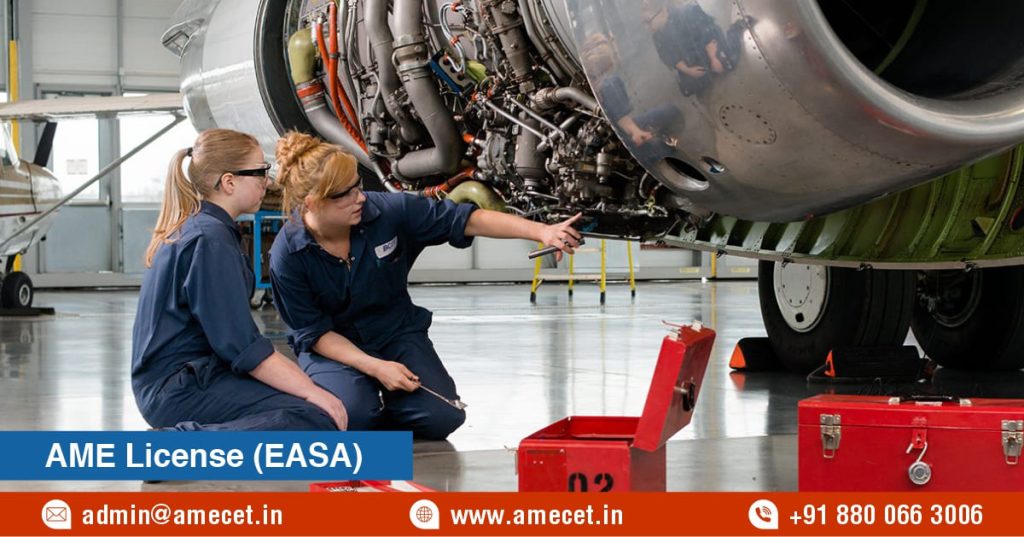What Are the Requirements for an EASA AME License?
Posted on : 23 August, 2024 6:20 pm
To obtain an EASA Aircraft Maintenance Engineer (AME) license, candidates must meet specific requirements. Firstly, they need to complete an approved training course from a recognized EASA Part-147 organization, covering both theoretical and practical components. Candidates must also pass multiple module exams and demonstrate competence in various maintenance tasks. Additionally, gaining practical experience is essential, typically requiring several years of hands-on work in an EASA-approved maintenance environment. Finally, candidates must successfully pass an oral examination conducted by an EASA-approved examiner to obtain the license.
Page Contents
ToggleEducational Prerequisites
Before pursuing an EASA AME license, candidates must meet certain educational prerequisites. Typically, this includes completing secondary education with a strong focus on science and mathematics. Many candidates also benefit from having a technical diploma or degree related to engineering or aviation. This foundational education is crucial, as it equips candidates with the necessary knowledge to grasp complex aircraft systems and maintenance procedures during their training.
Points:
- High school diploma or equivalent.
- Strong background in mathematics.
- Proficiency in physics.
- Technical or vocational training in engineering.
- Coursework in electronics.
- Basic understanding of aviation principles.
- English language proficiency.
- Recommended: Associate or Bachelor’s degree in a related field.
Theoretical Training Requirements
Theoretical training is a critical component of obtaining an EASA AME license. This training covers essential subjects such as aerodynamics, aircraft systems, avionics, and regulations. Conducted through EASA Part-147 approved institutions, the coursework is designed to build a comprehensive understanding of aircraft maintenance principles. Candidates must pass rigorous exams in each module to demonstrate their theoretical knowledge, which is fundamental for safe and effective maintenance practices.
Points:
- Aerodynamics and flight principles.
- Aircraft systems and components.
- Avionics and electronics.
- Materials and hardware.
- Human factors in aviation.
- EASA regulations and standards.
- Maintenance practices and procedures.
- Safety management systems.
Practical Training Components
Practical training is essential for acquiring an EASA AME license, providing hands-on experience with real aircraft and maintenance tasks. Conducted under the supervision of licensed engineers, this training covers areas such as aircraft inspection, fault diagnosis, and repair techniques. Candidates must demonstrate their ability to apply theoretical knowledge in real-world scenarios, ensuring they can perform maintenance tasks accurately and safely. This experience is crucial for developing the skills needed for licensure.
Points:
- Aircraft inspection procedures.
- Fault diagnosis and troubleshooting.
- Repair and replacement techniques.
- Engine maintenance practices.
- Avionics system testing.
- Structural repairs.
- Use of maintenance tools and equipment.
- Compliance with safety regulations.
Examinations and Assessments
Examinations and assessments are crucial steps in obtaining an EASA AME license. Candidates must pass multiple written exams covering theoretical knowledge, including aircraft systems, maintenance practices, and safety regulations. Additionally, practical assessments evaluate a candidate’s ability to perform maintenance tasks under real-world conditions. These exams ensure that candidates have the comprehensive knowledge and practical skills necessary to maintain aircraft safely and effectively, meeting stringent EASA standards.
Points:
- Written exams on aircraft systems.
- Theoretical knowledge of maintenance practices.
- Safety regulations testing.
- Module-specific assessments.
- Practical skills evaluation.
- Fault diagnosis tests.
- Oral examinations.
- Competency-based practical assessments.
Medical Fitness Requirements
Medical fitness is a critical requirement for obtaining an EASA AME license. Candidates must meet specific health standards to ensure they can perform maintenance tasks safely and effectively. This includes regular medical examinations to assess physical fitness, vision, hearing, and overall health. Maintaining medical fitness is essential for the demanding nature of aircraft maintenance work, ensuring that engineers can perform their duties without risk to themselves or others.
Points:
- Regular medical examinations.
- Vision tests (near and distance).
- Hearing assessments.
- Cardiovascular health checks.
- Physical fitness evaluation.
- Neurological health screening.
- No history of substance abuse.
- Compliance with EASA medical standards.

